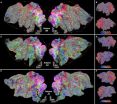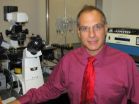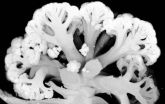(Press-News.org) For centuries, humans have been exploring, researching, and, in some cases, discovering how to stave off life-threatening diseases, increase life spans, and obtain immortality. Biologists, doctors, spiritual gurus, and even explorers have pursued these quests—one of the most well-known examples being the legendary search by Ponce de León for the "Fountain of Youth." Yet the key to longevity may not lie in a miraculous essence of water, but rather in the structure and function of cells within a plant—and not a special, mysterious, rare plant, but one that we may think of as being quite commonplace, even ordinary: the palm.
As an honors botany student at the University of Leeds, P. Barry Tomlinson wrote a prize-winning essay during his final year titled, "The Span of Life." Fifty years later, Tomlinson (now a Distinguished Professor at The Kampong Garden of the National Tropical Botanical Garden, Miami, FL) teamed up with graduate student Brett Huggett (Harvard University, Cambridge, MA) to write a review paper exploring the idea that palms may be the longest-lived tree, and whether this might be due to genetic underpinnings.
Having retained his essay in his personal files, Tomlinson found that it provided an excellent literature background for working on the question of cell longevity in relation to palms. Together, Tomlinson and Huggett published their review in the December issue of the American Journal of Botany (http://www.amjbot.org/content/99/12/1891.full.pdf+html).
A component of an organism's life span that biologists have been particularly interested in is whether longevity is genetically determined and adaptive. For botanists, discovering genetic links to increasing crop production and the reproductive lifespan of plants, especially long-lived ones such as trees, would be invaluable.
In their paper, Tomlinson and Huggett emphasize that in many respects, an organisms' life span, or longevity, is determined by the period of time in which its cells remain functionally metabolically active. In this respect, plants and animals differ drastically, and it has to do with how they are organized—plants are able to continually develop new organs and tissues, whereas animals have a fixed body plan and are not able to regenerate senescing organs. Thus, plants can potentially live longer than animals.
"The difference in potential cell longevity in plants versus animals is a significant point," states Tomlinson. "It is important to recognize that plants, which are so often neglected in modern biological research, can be informative of basic cell biological features in a way that impacts human concern at a fundamental level."
The authors focused their review on palm trees because palms have living cells that may be sustained throughout an individual palm's lifetime, and thus, they argue, may have some of the longest living cells in an organism. As a comparison, in most long-lived trees, or lignophytes, the main part, or trunk, of the tree is almost entirely composed of dead, woody, xylem tissues, and in a sense is essentially a supportive skeleton of the tree with only an inner ring of actively dividing cells. For example, the skeleton of Pinus longaeva may be up to 3000 years old, but the active living tissues can only live less than a century.
In contrast, the trunks of palms consist of cells that individually live for a long time, indeed for the entire life of an individual.
Which brings up the question of just how long can a palm tree live? The authors point out that palm age is difficult to determine, primarily because palms do not have secondary growth and therefore do not put down annual or seasonal growth rings that can easily be measured. However, age can be quite accurately assessed based on rate of leaf production and/or visible scars on the trunk from fallen leaves. Accordingly, the authors found that several species of palm have been estimated to live as long as 100 and even up to 740 years. The important connection here is that while the "skeleton" of the palm may not be as old as a pine, the individual cells in its trunk lived, or were metabolically active, as long as, or longer than those of the pine's.
Most plants, in addition to increasing in height as they age, also increase in girth, putting down secondary vascular tissue in layers both on the inner and outer sides of the cambium as they grow. However, palms do not have secondary growth, and there is no addition of secondary vascular tissue. Instead, stem tissues are laid down in a series of interconnected vascular bundles—thus, not only is the base of the palm the oldest and the top the youngest, but these tissues from old to young, from base to top, must also remain active in order to provide support and transport water and nutrients throughout the tree.
Indeed, the authors illustrate this by reviewing evidence of sustained primary growth in two types of palms, the coconut and the sago palm. These species represent the spectrum in tissue organization from one where cells are relatively uniform and provide both hydraulic and mechanical functions (the coconut) to one where these functions are sharply divided with the inner cells functioning mainly for transporting water and nutrients and the outer ones for mechanical support (the sago palm). This represents a progression in specialization of the vascular tissues.
Moreover, there is evidence of continued metabolic activity in several types of tissues present in the stems of palms, including vascular tissue, fibers, ground tissue, and starch storage. Since the vascular tissues in palms are nonrenewable, they must function indefinitely, and Tomlinson and Huggett point out that sieve tubes and their companion cells are remarkable examples of cell longevity as they maintain a long-distance transport function without replacement throughout the life of the stem, which could be for centuries.
Despite several unique characteristics of palms, including the ability to sustain metabolically active cells in the absence of secondary tissues, seemingly indefinitely, unlike conventional trees, in which metabolically active cells are relatively short-lived, the authors do not conclude that the extended life span of palms is genetically determined.
"We are not saying that palms have the secret of eternal youth, and indeed claim no special chemical features which allows cells in certain organisms to retain fully differentiated cells with an indefinite lifespan," states Tomlinson. "Rather, we emphasize the distinctive developmental features of palm stems compared with those in conventional trees."
Tomlinson indicates that this reflects the neglect of the teaching of palm structure in modern biology courses. "This paper raises incompletely understood aspects of the structure and development of palms, emphasizing great diversity in these features," he concludes. "This approach needs elaborating in much greater detail, difficult though the subject is in terms of conventional approaches to plant anatomy."
INFORMATION:
Tomlinson, P. Barry and Brett A. Huggett. 2012. Cell longevity and sustained primary growth in palm stems. American Journal of Botany 99(12): 1891-1902. DOI: 10.3732/ajb.1200089
The full article in the link mentioned is available for no charge for 30 days following the date of this summary at http://www.amjbot.org/content/99/12/1891.full.pdf+html. After this date, reporters may contact Richard Hund at ajb@botany.org for a copy of the article.
The Botanical Society of America (www.botany.org) is a non-profit membership society with a mission to promote botany, the field of basic science dealing with the study and inquiry into the form, function, development, diversity, reproduction, evolution, and uses of plants and their interactions within the biosphere. It has published the American Journal of Botany (www.amjbot.org) for nearly 100 years. In 2009, the Special Libraries Association named the American Journal of Botany one of the Top 10 Most Influential Journals of the Century in the field of Biology and Medicine.
For further information, please contact the AJB staff at ajb@botany.org.
Do palm trees hold the key to immortality?
Recent review reveals unique cellular structure and function that may contribute to their long life-span
2012-12-19
ELSE PRESS RELEASES FROM THIS DATE:
Study reveals how the brain categorizes thousands of objects and actions
2012-12-19
VIDEO:
Humans perceive numerous categories of objects and actions, but where are these categories represented spatially in the brain? Researchers reporting in the Dec. 20 issue of the Cell Press journal...
Click here for more information.
Humans perceive numerous categories of objects and actions, but where are these categories represented spatially in the brain? Researchers reporting in the December 20 issue of the Cell Press journal Neuron present their study that undertook ...
Western University-led research debunks the IQ myth
2012-12-19
After conducting the largest online intelligence study on record, a Western University-led research team has concluded that the notion of measuring one's intelligence quotient or IQ by a singular, standardized test is highly misleading.
The findings from the landmark study, which included more than 100,000 participants, were published today in the journal Neuron. The article, "Fractionating human intelligence," was written by Adrian M. Owen and Adam Hampshire from Western's Brain and Mind Institute (London, Canada) and Roger Highfield, Director of External Affairs, Science ...
Brake on nerve cell activity after seizures discovered
2012-12-19
SAN ANTONIO (Dec. 19, 2012) — Given that epilepsy impacts more than 2 million Americans, there is a pressing need for new therapies to prevent this disabling neurological disorder. New findings from the neuroscience laboratory of Mark S. Shapiro, Ph.D., at The University of Texas Health Science Center at San Antonio, published Dec. 20 in the high-impact scientific journal, Neuron, may provide hope.
"A large fraction of epilepsy sufferers cannot take drugs for their disorder or the existing drugs do not manage it," said Dr. Shapiro, professor of physiology in the School ...
UofL scientist uncovers how airway cells regenerate after chlorine gas injury
2012-12-19
LOUISVILLE, Ky. - Scarring of the airways can lead to long-term breathing problems for some people exposed to high levels of chlorine gas from events such as an industrial accident, chemical spill following a train derailment or terroristic chemical warfare. Household mishaps from mixing bleach with acidic cleaning products also can cause release of chlorine gas; if this occurs in a poorly ventilated space, chlorine levels could be high enough to cause lung injury.
University of Louisville scientist Gary Hoyle, Ph.D., School of Public Health and Information Sciences ...
Closest sun-like star may have planets
2012-12-19
Washington, D.C.— An international team of scientists, including Carnegie's Paul Butler, has discovered that Tau Ceti, one of the closest and most Sun-like stars, may have five planets. Their work is published by Astronomy & Astrophysics and is available online.
At a distance of twelve light years and visible with a naked eye in the evening sky, Tau Ceti is the closest single star with the same spectral classification as our Sun. Its five planets are estimated to have masses between two and six times the mass of the Earth--making it the lowest-mass planetary system yet ...
NTU study finds ways to prevent muscle loss, obesity and diabetes
2012-12-19
A research study from Nanyang Technological University (NTU) has yielded important breakthroughs on how the body loses muscle, paving the way for new treatments for aging, obesity and diabetes.
The study found that by inhibiting a particular molecule produced naturally in the body, muscle loss due to aging or illnesses can be prevented. Blocking the same molecule will also trigger the body to go into a 'fat-burning mode' which will fight obesity and also treat the common form of diabetes.
The exciting discoveries have led NTU scientists to embark on joint clinical research ...
Successful results against human leishmaniasis with a more efficient and economic vaccine
2012-12-19
A research coordinated by the UAB has succeeded in testing a vaccine against leishmaniasis. The vaccine was tested with the best animal model existing, the golden hamster, and can be produced at low costs by using insect larvae. The research, published in the latest edition of PLoS ONE, is an important step towards the fight against a disease which causes the death of 70,000 people each year in developing countries and of countless dogs, which also suffer from this disease and are its natural reservoir.
Leishmaniasis is one of the main health problems existing at global ...
A mathematical formula to decipher the geometry of surfaces like that of cauliflower
2012-12-19
This press release is available in Spanish.
VIDEO:
This is a cauliflower.
Click here for more information.
The scientists have found a formula that describes how the patterns found in a multitude of natural structures are formed. "We have found a model that describes, in detail, the evolution in time and in space of cauliflower-type fractal morphologies for nanoscopic systems", explains ...
Geo-engineering against climate change
2012-12-19
Numerous geo-engineering schemes have been suggested as possible ways to reduce levels of the greenhouse gas carbon dioxide in the atmosphere and so reduce the risk of global warming and climate change. One such technology involves dispersing large quantities of iron salts in the oceans to fertilize otherwise barren parts of the sea and trigger the growth of algal blooms and other photosynthesizing marine life. Photosynthesis requires carbon dioxide as its feedstock and when the algae die they will sink to the bottom of the sea taking the locked in carbon with them.
Unfortunately, ...
Better approach to treating deadly melanoma identified by scientists
2012-12-19
Scientists at The University of Manchester have identified a protein that appears to hold the key to creating more effective drug treatments for melanoma, one of the deadliest cancers.
Researchers funded by Cancer Research UK have been looking at why new drugs called "MEK inhibitors", which are currently being tested in clinical trials, aren't as effective at killing cancer cells as they should be.
They discovered that MITF - a protein that helps cells to produce pigment but also helps melanoma cells to grow and survive - is able to provide cancer cells with a resistance ...
LAST 30 PRESS RELEASES:
School meals could unlock major gains for human and planetary health
Menopause hormone therapy does not appear to impact dementia risk
Signature patterns of brain activity may help predict recovery from traumatic brain injury
Dresden study uncovers new key mechanism in cancer cells
New species are now being discovered faster than ever before, study suggests
Cannabis-based products show limited short-term benefit for chronic pain, with increased risk of adverse effects
Cannabis products with more THC slightly reduce pain but cause more side effects
Clearing the brain of aging cells could aid epilepsy and reduce seizures
Brain injuries linked with potential risk of suicide, new study finds
New technique lights up where drugs go in the body, cell by cell
New study finds movement of fishing fleets can reveal shifts in marine ecosystems
Embargoed: New evidence points to potential treatment for vascular dementia
Study uncovers disrupted brain balance in alcohol dependence
Working in groups can help Republicans and Democrats agree on controversial content moderation online
Structural findings reveal how distinct GPCR ligands create different levels of activation
Anything-goes “anyons” may be at the root of surprising quantum experiments
UC review: Maximizing workplace opportunity for veterans
From generation to complex control: Metasurfaces make perfect vortex beams "within reach"
Thin-film lithium niobate-based detector: recent advances and perspectives
Exploring why some people may tend to persistently make bad choices
How cells balance their protein levels
Nirsevimab vs RSVpreF vaccine for RSV–related hospitalization in newborns
Effectiveness and impact of maternal RSV immunization and nirsevimab on medically attended RSV in US children
AI gives scientists a boost, but at the cost of too many mediocre papers
Next-generation vision model maps tree growth at sub-meter precision
Genes aren’t destiny for inherited blindness, study shows
MIT study: High-fat diets make liver cells more likely to become cancerous
Exposure to multiple fine particulate matter components and incident depression in the US Medicare population
Risk of burdensome health care spending over time in the US
Nirsevimab against hospitalizations and emergency department visits for lower respiratory tract infection in infants
[Press-News.org] Do palm trees hold the key to immortality?Recent review reveals unique cellular structure and function that may contribute to their long life-span




